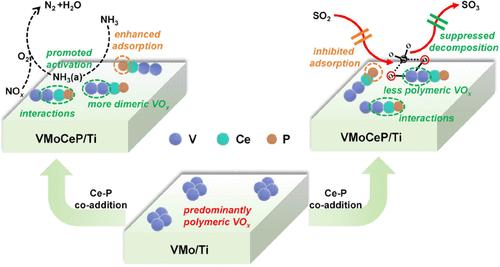Ce和P商品化同时抑制SO2氧化和提高VMo/Ti催化剂的脱氧活性
IF 11.3
1区 环境科学与生态学
Q1 ENGINEERING, ENVIRONMENTAL
引用次数: 0
摘要
在利用NH3 (NH3 - scr)工艺选择性催化还原NOx的过程中,如何提高活性并减少SO3的排放仍然是一个挑战。本文中,Ce和P共同修饰了VMo/Ti催化剂来解决这一挑战。在250 ~ 350℃的温度范围内,最佳VMoCeP/Ti催化剂的NO转化率达到95%以上,SO2氧化率保持在1.0%以下。Ce和P的加入提高了催化剂的表面酸度和氧化还原能力,促进了NH3的吸附和活化。同时,Ce和P的共加成可以调节钒基物质的表面结构,使其由聚合物为主转变为二聚体,从而促进SCR反应。更重要的是,除了抑制钒种的硫化外,较低的聚合钒基种类比例和V-Ce-P种类之间的强相互作用都可以提高硫化钒种分解成SO3的能垒,从而抑制SO2氧化。这项工作为开发具有低SO2氧化率的高效SCR催化剂提供了新的见解,无论是在学术领域还是在工业领域。本文章由计算机程序翻译,如有差异,请以英文原文为准。

Simultaneously Inhibiting SO2 Oxidation and Improving deNOx Activity over the VMo/Ti Catalyst by Ce and P Comodification
Both improving the activity and reducing SO3 emissions during selective catalytic reduction of NOx by the NH3 (NH3–SCR) process over commercial V–Ti-based catalysts remain a challenge. Herein, Ce and P cooperatively modified the VMo/Ti catalyst to address this challenge. Within the temperature range of 250–350 °C, the optimal VMoCeP/Ti catalyst achieved a NO conversion of more than 95% and maintained a SO2 oxidation ratio below 1.0%. The enhanced SCR activity of the modified catalyst could be attributed to the improvement in surface acidity and redox capacity by the addition of Ce and P, which would promote NH3 adsorption and activation. Meanwhile, Ce and P coaddition could regulate the surface structure of vanadyl species from predominantly polymeric to a more dimeric form, which could also promote the SCR reaction. More importantly, except for the suppressed sulfation of vanadium species, both a lower proportion of polymeric vanadyl species and the strong interactions among V–Ce–P species could raise the energy barrier of the decomposition of sulfated vanadium species into SO3, thereby inhibiting SO2 oxidation. This work provided novel insights into developing efficient SCR catalysts with low SO2 oxidation ratios for both the academic and industrial fields.
求助全文
通过发布文献求助,成功后即可免费获取论文全文。
去求助
来源期刊

环境科学与技术
环境科学-工程:环境
CiteScore
17.50
自引率
9.60%
发文量
12359
审稿时长
2.8 months
期刊介绍:
Environmental Science & Technology (ES&T) is a co-sponsored academic and technical magazine by the Hubei Provincial Environmental Protection Bureau and the Hubei Provincial Academy of Environmental Sciences.
Environmental Science & Technology (ES&T) holds the status of Chinese core journals, scientific papers source journals of China, Chinese Science Citation Database source journals, and Chinese Academic Journal Comprehensive Evaluation Database source journals. This publication focuses on the academic field of environmental protection, featuring articles related to environmental protection and technical advancements.
 求助内容:
求助内容: 应助结果提醒方式:
应助结果提醒方式:


